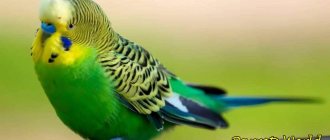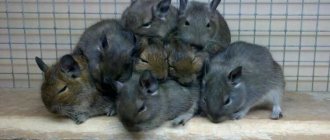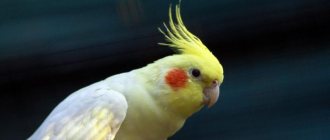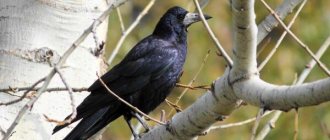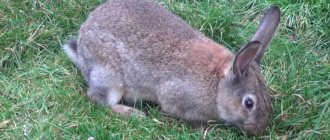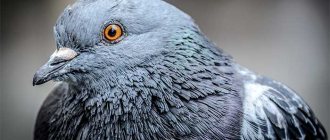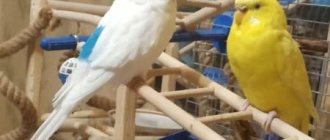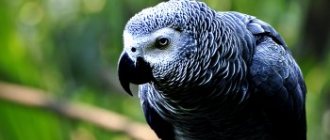All about lovebirds
These are flocking birds, however, they are aggressive towards birds of other species and can even attack an individual much larger than themselves. They settle near bodies of water. They sleep in trees, clinging to small twigs with their paws so as not to fall. They eat directly from the branch and do not take food into their paws. They often raid fruit plantations and destroy agricultural plantations. Excellent and they fly a lot. They nest in hollows, empty holes, under roof canopies and in the walls of residential buildings.
Appearance
Lovebirds are small birds with a body length varying depending on the variety and gender from 10 to 17 cm and weighing about 50 grams. The length of the parrot's wing is only 4 cm, and the tail, rounded at the end, is 6 cm. The lovebird has disproportionately short legs relative to the body and a large head. Birds have a powerful curved beak.
Important! In lovebirds, the main feather color is determined by two pairs of unlinked non-allelic genes. This means that in addition to the common green one, you can find white, blue, and yellow parrots.
Types of lovebirds with photos
Lovebirds are divided into 9 subspecies, each of which has its own distinctive features, primarily related to the description of external data.
- Collared (Agapornis swindernianus) - body length 13 cm. A distinctive feature is a collar in the form of an orange thin stripe on a dark neck. The beak is almost black. The breast has a yellowish tint, and the plumage under the tail is blue.
- Masked (Agapornis personatus) - body length 15 cm. The predominant color of the plumage is orange-yellow, but the tail, back, abdomen and wings are green. The beak stands out as a red spot on the brown-black head.
- Red-faced (Agapornis pullarius) - body length 15 cm. Males are green, females have greenish-yellow shades in their plumage. The frontal area, cheeks and throat are colored rich orange-red. Females have a completely orange head.
- Rosy-cheeked (Agapornis roseicollis) - body length 17 cm, while males are smaller than females, but their color is many times more intense. The parrot is olive in color with a bluish tint. The pink on the bird's cheeks and throat gradually turns into deep red on the forehead. The beak is straw-colored.
- Black-cheeked (Agapornis nigrigenis) - body length 14 cm. Similar to masked lovebirds with a difference in the color of the head - it has a grayish tint. An orange-pinkish color is present in the plumage of the upper half of the breast and gradually turns green downwards.
- Blackwings (Agapornis taranta) - body length from 17 cm or more (the largest of the lovebirds). The bird is bottle green in color. The frontal region, eye rims and beak are bright scarlet. The wings are outlined with a black border.
- Grey-headed (Agapornis canus) - body length 14 cm. Green parrot. Starting from the head to the middle of the chest, the color of the male’s plumage is light gray, almost white. In the female, this area is colored grayish-green.
- Lilianas (Agapornis lilianae) - body length 15 cm. They are similar to pink-cheeked lovebirds with the only difference that the head and neck have a more saturated color. The back and wings of the parrot are much darker than the belly and chest. The bird's beak is bright red.
- Fischer's lovebirds (Agapornis fischeri) - body length maximum 15 cm. Yellowish-green parrot with bright golden-orange coloring of the head and neck with brownish splashes. The tail feathers have a blue tint at the end. The beak is red.
Collared
Masked
Red faces
Rosy-cheeked
Black-cheeked
Blackwings
Grey-headed
Liliana's lovebird
Fisher's lovebirds
Lovebirds - why they were called that
It is no coincidence that the birds were called lovebirds. It has long been believed that the male lovebird parrot is monogamous and chooses a mate for himself once and for the rest of his life. If one of the parrots dies, then soon, unable to bear the separation, the other will follow him out of sadness. In practice, everything is different; an orphaned bird can easily build a relationship with a new feathered partner.
Natural habitats
Depending on the species, lovebirds inhabit the forests of the tropics and subtropics; some species prefer mountainous areas and steppe plains.
Geographically, lovebirds live in the southeast, southwest and central Africa, and to be more precise:
- collared - in central Africa and the southwest of the continent;
- masked - in Kenya and on the east African coast in Tanzania;
- red-faced - in Ethiopia, Tanzania, Sao Tome, Sierra Leone;
- rosy-cheeked - in South Africa, Namibia and Angola;
- black-cheeked - in the southwest of Zambia;
- black-winged - in Ethiopian forests and mountains, as well as in northeast Africa;
- grey-headed - on the islands of Madagascar, Zanzibar, Mauritius, in the Seychelles in palm and date plantations;
- Liliana's lovebirds - in the eastern district of Zambia, southern Tanzania and northern Mozambique;
- Fisher's lovebirds - in northern Tanzania.
Character and abilities
The lovebird adapts well to new conditions, quickly gets used to people, and is devoted to its owner. Shy, may die from a broken heart. At the same time, he is curious and cocky. Has a good memory and high intelligence. Finds its cage, responds to its name, and can be trained.
Those who have ever heard lovebirds sing are concerned about how often they do this. After all, the voice of a bird seems unpleasant and loud to most people, but, in truth, it never screams without a reason, and it screams quite rarely.
You can listen to lovebirds singing in this video:
Can a parrot live alone?
Although parrots are called inseparable, they are quite capable of living alone. But since the bird is a flock, the owner must make up for the lack of communication with its feathered relatives. When deciding to place a couple with a parrot, a number of conditions must be met, and there are no guarantees that they will eventually get along.
- Only birds of the same species can get along together.
- More than one pair of lovebirds is not kept in one cage, but it is permissible for the birds to be of the same sex.
- It is better if the parrots are the same age, or the male is slightly older than the female (if the pair is of different sexes), otherwise the mature female may peck the young male to death.
How to tame
It is easier to tame a small parrot born and raised in captivity. It will never be possible to completely tame an adult bird, especially one caught in the wild. Taming occurs gradually, starting with treating the pet with a treat through the bars of the cage, and then on neutral territory until the parrot sits on the owner’s hand.
How to teach to talk
Lovebirds can be taught to speak 10-15 words, provided that the student is isolated from other birds during the entire training. Attempts to teach a pair of lovebirds to talk at once are doomed to failure from the very beginning. Moreover, these parrots are trainable only at an early age - up to 1 month.
It is difficult to become a speaker after a long period of training, so you will have to be patient. You will need to pronounce the same words loudly and clearly with different intonations and do this regularly for quite a long time.
Night sleep disorders
It's a bad sign if the parrot doesn't sleep after dark. He probably complains, making loud and incomprehensible sounds. He doesn’t sit still, he rushes about. First of all, you need to carefully examine the bird for any injuries.
She could fall from the perch in her sleep, losing her balance, and hurt herself. If a wound is found, it is treated in the same way as a child’s – with hydrogen peroxide, for example. But there may be a turning point. In the morning, it is advisable to show your pet to a doctor.
Most often, sleep is disturbed by fear. What alarmed the bird? Yes, anything, even a shadow running along the wall from the headlights of a passing car. It is necessary to create conditions for rest - silence, darkness, and a miracle will happen - the troublemaker will fall asleep.
How parrots sleep. Shurik is sleeping.
There may be other reasons for his concern. Diseases of internal organs. Parasites, finally. An ornithologist will definitely find out the truth if you contact him.
Purchase and prices for lovebirds
It is better to purchase a lovebird from an experienced breeder. When choosing a pet, first of all, pay attention to the appearance of the parrot and its activity - the main indicators of health.
If the parrot is young, then its color will not be very bright - this is normal. Six months later, when the first moult of lovebirds takes place, their plumage will become more saturated colors.
Pink-cheeked lovebirds are more popular for keeping at home. The price per individual will not exceed 2.5-3 thousand rubles. Fischer and masked parrots will cost a little more.
Floor
If you plan to keep a pair, you still buy a male first. When he gets used to it, you can choose a girl who will immediately be placed in his cage.
If you do it differently and place a boy with an already tamed female, they are unlikely to be able to become friends, because birds have a matriarchy. Females will spread rot and knock the guest. They can even maim and kill. They are much stronger and larger than males.
Which gender is preferable?
Keeping at home
It is easy to cope with the task of how to properly care for lovebirds if you comply with a number of conditions:
- maintain the air temperature in the room with the feathered pet at 20-25⁰С;
- Avoid drafts, excessive humidity or dry air. Install a humidifier and maintain humidity at 50-60%;
- take the cage with the parrots out into the fresh air in the warm season;
- the bird must sleep for 15 hours, so in the summer the cage must be covered with a cape at night, shortening the daylight hours.
How do lovebirds sleep in winter, when night takes up most of the day? For parrots, the number of hours of sleep and wakefulness should remain unchanged. To do this, you need to install a UV lamp at a distance of 1 m from the cage - a source of additional lighting.
Arrangement of the cage
For one lovebird, a cage with dimensions from 80x30x40 cm is suitable. Keeping lovebirds in pairs means a larger house - from 100x40x50 cm or more. The cage should be square or rectangular in shape. Suitable materials of manufacture are nickel, plexiglass and plastic. The minimum distance between the rods is 1.5 cm. It is advisable that the cage be equipped with a retractable tray.
A layer of sawdust or river sand, previously calcined in the oven, is poured onto the bottom of the cage. In addition, the cage contains:
- 2 feeders and 1 drinker per individual;
- wooden perches with a diameter of 1.5 to 2 cm each;
- toys for lovebirds: ropes, swings, ladders, rings, etc.
Diet
The basis for feeding a lovebird at home is grain mixtures (the norm is 1-2 tbsp per day). You can buy a ready-made grain mix from imported manufacturers or prepare it yourself from the following ingredients:
- cereals,
- oat grains,
- crushed corn,
- millet,
- canary seed,
- sunflower seeds,
- dried fruits and nuts (optional in minimal dosage).
In addition, parrots are offered fresh vegetables, fruits, berries and herbs every day. Animal products: low-fat cottage cheese and a hard-boiled egg are given once a week. A lovebird can sharpen its beak with the help of fruit branches. Also, chalk, charcoal or activated carbon should always be freely available.
Important! Lovebirds should not eat avocados, mangoes and persimmons, candied berries, sweet and fried foods, coffee and alcohol.
Grain feed is poured into the feeder in the evening, the entire daily requirement at once. Feeding with vegetables and fruits is carried out in the morning. They are placed in a separate feeder, replaced with fresh ones during the day, and the remains are completely removed at night.
Care and hygiene
Care that has a beneficial effect on the life of lovebirds at home includes, among other things, mandatory hygiene procedures. Every week, the cage, perches and toys are washed with hot soapy water, doused with boiling water and dried thoroughly. Feeders are cleaned daily immediately before being filled with fresh food and water.
Regarding how to wash the lovebird itself (which is very important for its harmonious development and maintenance of health): daily in the summer and twice a week in the winter.
The bird bathes either in a separate bathing suit filled with clean water without soap to a depth of 2 cm, or in a sink under the tap. The optimal water temperature for swimming is 27⁰C.
Reproduction at home
The summer and first autumn months are considered favorable times for mating, although lovebirds that have reached the age of one can breed all year round. Before mating, lovebirds create favorable conditions for the couple: they are intensively fed protein foods, and daylight hours are artificially increased to 14-15 hours.
The nesting house is placed in the cage after half a month, and thin twigs are also placed from which the female will build a nest. There she will lay 4-8 eggs, after 20 days they will hatch into naked, blind and deaf chicks. After 10 days, the lovebirds will open their eyes, in a month they will fledge and in another week they will leave the nesting house. Parents will feed the babies for 2 months, after which the parrots can be resettled.
How to determine gender and age
You can determine the sex of birds by judging by how lovebirds look, that is, by external signs depending on the species, and also by knowing some tricks:
- if you look at the parrot in profile, the male’s head seems more elongated and flat;
- the female is more active and talkative than the male;
- If you throw a piece of paper into a bird's cage, the male will be indifferent to it, but the female will begin to tear off small pieces and stuff them under her tail. This is how she makes provisions for the future nest.
The size of adult individuals does not differ from younger ones, so age cannot be determined using this parameter. But there are ways here too:
- in chicks up to 6 months old, green feathers have a grayish tint, which disappears as they grow older;
- the skin over the beak of parrots up to 3 months of age is dark in color;
- babies have lighter and smoother paws, which become covered with more and more dark scales as they age;
- in the first few months, lovebirds have enlarged pupils and almost completely cover the whites of the eyes;
- up to 3 months, parrots have impaired balance, they fly poorly.
You will learn a few more tips on how to determine the sex of lovebirds from this video:
Correct sleeping position
The peculiarity of sleeping while sitting on one leg is unique, except that only other species of birds can be compared with cute talkers. Many of them also settle down to take a nap on branches or on a perch.
Sleeping positions for parrots
Adult wavy cats and representatives of other breeds cling to this twig with only one paw. Even the herons have it easier, although they also press their other leg. They stand on the ground, the surface of which does not shake.
Parrots have amazing coordination! It doesn't appear right away. Young chicks sleep on two legs for a long time until they learn how to do it.
There is a second feature of the pose. Try not only balancing on one leg, but also placing your head on your back! Parrots can do it! This situation does not cause them any anxiety; they feel safe and comfortable. Often lovebirds sleep side by side, huddled closely, and one of them rests his head on the back of the other.
Diseases and prevention
The most common diseases in parrots in captivity include:
- infectious diseases,
- damage by ticks and lice eaters,
- helminthic infestation,
- avitaminosis,
- obesity,
- gout,
- poisoning,
- incessant shedding,
- bruises, dislocations, fractures, etc.
The weak point of lovebirds is their eyes. Thus, swelling of the eyelids and eye injuries without proper treatment lead to complications, including blindness. What to do if a lovebird has the initial stage of glaucoma - only a veterinarian can determine; it is unacceptable to engage in independent treatment.
To prevent a number of dangerous diseases, lovebird chicks at the age of 2 months must be vaccinated and revaccinated every month until the birds reach 5 months of age. At 6 months, you can vaccinate your parrot against rabies for the first time, followed by booster vaccinations according to schedule.
Life expectancy, causes of death
Not a single individual of this species will live in natural conditions as long as lovebirds live with proper care at home - and this is no less than about 15 years, and sometimes more. In the wild, the bird's life expectancy is limited to a maximum of 10 years due to lack of food and water during drought, difficult flights, defending its territories in fights, attacks by predators and the mass extermination of parrots by farmers.
How to create comfortable conditions for a feathered pet to rest?
I have already talked about how the sleep of little parrots is organized. Now let's talk about the big ones. For example, a cockatiel is quite large and strong, how can you please it? There is nothing to be afraid of.
Creating comfortable conditions for the parrot to rest
With proper care and sufficiently large space for living, this pet seems unpretentious. Breeds like this require space and freedom. It is better to give the bird the entire room at its disposal, but first remove dangerous objects from there.
In a cramped cage one cannot avoid depressed mood, apathy, and subsequently even muscle dystrophy. Corella does not want such a fate, and therefore may rebel and show aggression.
You need to be given the opportunity to hide or retreat somewhere, and if there is nowhere to hide from the apparent danger, the strong-billed flyer will certainly attack. This is his only defense in this situation.
Consequences of lack of sleep in parrots
And the more he worries about his safety, the less soundly he sleeps. And chronic lack of sleep threatens many health problems.
For example:
- shedding feathers in incredible quantities;
- furious self-plucking;
- lethargy, drowsiness;
- nervous behavior;
- aggression;
- depression;
- acquiring offspring contrary to the plans of the owner.
